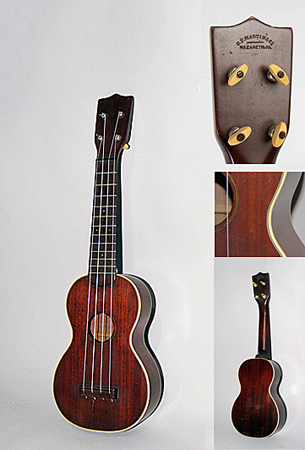
Owner: HWMC
Catalog#: 2CL-CHLT-130
Chordophones - Lutes
1920s Martin ‘Style 2’ Soprano Ukulele
Nazareth, Pennsylvania
C. F. Martin & Company
Mahogany, celluloid, metal
ca. 1920s
Total Length: 21 in; Body Length: 9 7/16 in; Body Width: 6 3/8 in; Scale Length: 13 5/8 in
Chordophones – Lutes
Engraved on back of peg head: C. F. MARTIN & CO / NAZARETH, PA.
Engraved inside sound hole: C. F. MARTIN & CO / NAZARETH, PA.
This is an all-original 1920s C.F. Martin & Co ‘Style # 2 – Soprano’ Ukulele fabricated in Nazareth, PA USA. The date is established as the logo is engraved both on the back of the peghead and engraved inside of the sound hole. (Martin ukes have the Martin stamp on the back of the peghead until 1935, when they started painting the logo on the front of the peghead). This ukulele has the classic style mahogany wood top, back, sides, and neck ‘stained’ to a dark rich color. There are 12 metal frets, a rosewood fretboard and a mahogany wood bridge. Featured is the white celluloid binding around the top and back of the body and a traditional concentric circle purfling rosette around the sound hole. There are four “patent” tuners made by Grover (1921) with white celluloid buttons, and four small celluloid dots, one at the fifth fret, two at the seventh, and one at the tenth.
The ukulele was developed in the 1880s by Portuguese immigrants from Madeira, a small mountainous speck of land in the Atlantic southwest of Portugal, about 350 miles from the coast of North Africa. In particular, three immigrant Madeiran cabinet makers: Manuel Nunes, José do Espírito Santo, and Augusto Dias, are credited with introducing the ukulele to Hawaii. These three men disembarked on the sailing vessel SS Ravenscrag, as contract laborers for the sugar plantations in Honolulu. Four months later they arrived in the Hawaiian Islands, late August, 1879. At first they delighted the people with nightly street concerts, as they fulfilled their contract to work in the sugar plantations on Hawaii, Maui, and Kauai, during the day. They played on a small, guitar-like, four-string instrument called the “machête” (pronounced “ma-CHET”), also known as the “braguinha” or the “machéte de Braga” named after the city in northern Portugal where the instrument originated.
After Nunes, Dias, and Santo, fulfilled their contractual obligations, they all headed straight for Honolulu with the ambition of returning to their former profession in woodworking. There, all three started building “machêtes” that looked a lot like ukuleles while pursuing general woodworking jobs, probably as a side business to earn extra money.
Another important factor in the introduction of the ukulele, was the ardent support and promotion of the instrument by King Kalākaua, an accomplished musicians and patron of the arts, who incorporated it into performances at royal gatherings. The word ukulele roughly translates as “jumping flea”, perhaps because of the movement of the player’s fingers. Legend attributes it to the nickname of Englishman Edward William Purvis, one of King Kalākaua’s officers, because of his fidgety manner, and playing expertise.
Resource: https://ukulelemagazine.com/stories/martin-ukuleles-history
